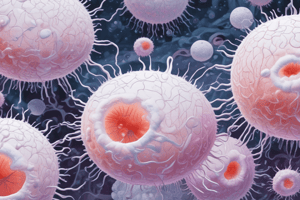Podcast
Questions and Answers
What is the purpose of Propylene Glycol in the diluting fluid?
What is the purpose of Propylene Glycol in the diluting fluid?
lyse the RBCs
What is the function of Phyloxine in the diluting fluid?
What is the function of Phyloxine in the diluting fluid?
stain eosinophils red
Why is Heparin added to Pilot's Solution?
Why is Heparin added to Pilot's Solution?
prevent WBC clumping
How is the cell count computed after counting with the Thoma Pipet?
How is the cell count computed after counting with the Thoma Pipet?
Which component of the Diluting Fluid helps in lysing WBCs except Eosinophils?
Which component of the Diluting Fluid helps in lysing WBCs except Eosinophils?
What is the first stage of the Granulocytic Series?
What is the first stage of the Granulocytic Series?
Which type of cell is characterized by pink specific granules?
Which type of cell is characterized by pink specific granules?
Eosinophilia refers to a decreased eosinophils count.
Eosinophilia refers to a decreased eosinophils count.
The Largest cell in the bone marrow is the ________.
The Largest cell in the bone marrow is the ________.
Match the following WBC appearance descriptions with the correct cell type:
Match the following WBC appearance descriptions with the correct cell type:
Flashcards
Myeloblast
Myeloblast
The first stage in the granulocytic series, found only in bone marrow. It is characterized by a high N:C ratio (4:1), fine chromatin, and 2-5 nucleoli.
Promyelocyte
Promyelocyte
A stage in the granulocytic series characterized by the presence of primary (azurophilic) granules and a N:C ratio of 3:1 to 2:1.
Myelocyte
Myelocyte
A stage in the granulocytic series where secondary (specific) granules begin to appear. It is the last stage capable of mitosis.
Band
Band
Signup and view all the flashcards
Monoblast
Monoblast
Signup and view all the flashcards
Promonocyte
Promonocyte
Signup and view all the flashcards
Monocyte
Monocyte
Signup and view all the flashcards
Eosinophil
Eosinophil
Signup and view all the flashcards
Lymphoblast
Lymphoblast
Signup and view all the flashcards
WBC Count
WBC Count
Signup and view all the flashcards
Study Notes
Granulocytic Series
- Stages: myeloblast, promyelocyte, myelocyte, metamyelocyte, band, and mature granulocyte (ben)
- Myeloblast: • 15-20 um in diameter • N:C ratio 4:1 • Cytoplasm: moderate blue, no granules • Nucleus: round to oval, extremely fine chromatin, reddish purple, 2-5 nucleoli • First stage, found in bone marrow
- Promyelocyte: • 15-21 um in diameter • Cytoplasm: presence of primary (azurophilic) granules, blue to reddish purple • N:C ratio: 3:1 to 2:1
- Myelocyte: • 12-18 um in diameter • Secondary granules (specific granules) begin to appear • Last stage capable of mitosis
- Neutrophilic myelocyte: • pink specific granules
- Eosinophilic myelocyte: • dirty orange to red granules
- Basophilic myelocyte: • dark blue-purple specific granules
Band
- 9-15 um in diameter
- Sausage shape, narrow, horse shoe-shaped nucleus
- Indentation in nucleus is 1/3 the diameter of the cell
- Last stage found in bone marrow, first stage found in circulation (0-3% in circulation)
Monocytic Series
- Stages: monoblast, promonocyte, and monocyte
- Monoblast: • 12-20 um in diameter • Found in bone marrow, mature neutrophil • Cytoplasm: moderately basophilic or blue-gray • N:C ratio 4:1 • Nucleus: round or ovoid, light blue-purple, lacy chromatin, 1-2 nucleoli
- Promonocyte: • 14-18 um in diameter • Cytoplasm: ground glass appearance • May contain dust-like azurophilic granules • Nucleus: oval, may have a single fold or fissure, 1 nucleoli
- Monocyte: • 14-20 um in diameter • Cytoplasm: abundant, blue-gray, ground glass appearance due to many fine azurophilic granules • Irregular, presence of pseudopods • Nucleus: kidney-shaped, brain-like convolution, lacy chromatin, no nucleoli present
Eosinophil
- 10-16 um in diameter
- Dark purple to blue-black granules obscuring the nucleus
- Nucleus: bilobed or rarely 3-4 lobes
Lymphocytic Series
- Lymphoblast: • 10-18 um in diameter • Cytoplasm: no granules, more abundant than myeloblast, moderate to dark blue • Nucleus: round to oval, contain 1-2 distinct nucleoli • N:C ratio: 4:1
- Prolymphocyte: • Smaller than lymphoblast • Cytoplasm: moderate to dark blue, may contain occasional azurophilic granules • Round, ova or slightly indented, chromatin pattern is clumped, 1-2 nucleoli
- Lymphocyte: • 8-10 um in diameter • Cytoplasm: light blue, scanty to moderate, with few azurophilic granules • Nucleus: purple, dense, clumped chromatin, round, eccentric, no nucleoli
Megakaryocytic Series
- Stages: megakaryoblast, promegakaryocyte, granular megakaryocyte, mature megakaryocyte, and platelet
- Megakaryoblast: • 20-50 um in diameter • Cytoplasm: non-granular, blue, darker than myeloblast, with small, blunt pseudopods • Nucleus: round, oval, multiple nucleoli • N:C ratio: 10:1
- Promegakaryocyte: • 20-60 um in diameter • Cytoplasm: more abundant, less basophilic, granules begin to form • Nucleus: multiple nucleoli are visible, irregular in shape, may show lobulation • N:C ratio: 4:1 to 7:1
WBC Count
- Refers to the routine procedure that gives an approximation of the total number of leukocytes in the circulation
- Function of the WBC is to provide immunity, the ability to resist infection
- In a normal adult, WBC ranges from 4,000-11,000/mm3
- A count above normal is called leukocytosis, while a count below normal is called leukopenia
Direct Eosinophil Counting
- Eosinophil: a granulocyte present at sites of allergic reaction and parasitic infection
- Can be obtained indirectly by determining WBC count multiplied by the eosinophil differential
- Normal range: 50-350 x 10^6/L or 0.5-3.5% of WBC
- Eosinophilia: increased eosinophils above normal, causes include allergic reactions, parasitic infestation/infection, brucellosis, and certain leukemias
- Eosinopenia: decreased eosinophils count, causes include hyperadrenalism, shock, and ACTH administration
Studying That Suits You
Use AI to generate personalized quizzes and flashcards to suit your learning preferences.




